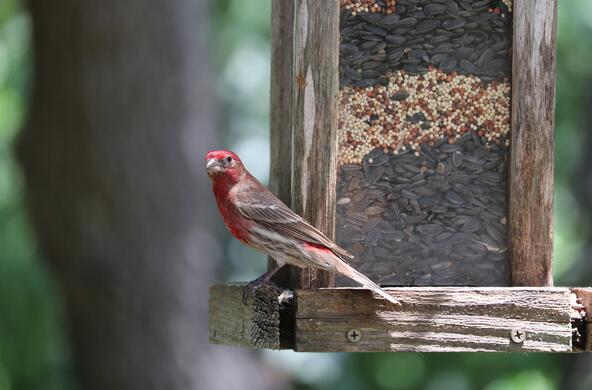When European settlers arrived in North America, they were stunned to discover a gorgeous parrot.
The face of the Carolina parakeet was red; its head was yellow, its wings green. Measuring a foot or more from beak to tail, the parakeets thrived in noisy flocks from the Atlantic Coast to what is now Oklahoma.
“I have seen branches of trees as completely covered by them as they could possibly be,” John James Audubon wrote in 1830. When the parrots landed on a farmer’s field, “they present to the eye the same effect as if a brilliantly coloured carpet had been thrown over them.”
Within a century, the Carolina parakeet was gone. In 1918, the last captive died in a Cincinnati zoo. After a few possible sightings in the wild, the species was declared extinct.
Today, scientists are left with little information about the bird. But now a team of researchers has sequenced the genome of a specimen that died a century ago. The genome offers clues to how the Carolina parakeet became America’s native parrot millions of years ago, and how it disappeared.
And the research, published in the journal Current Biology, may help scientists save other birds from its fate.
The new study was led by Carles Lalueza-Fox, an evolutionary biologist at Pompeu Fabra University in Barcelona. In 2016, he was invited to examine a specimen preserved in a private collection.
The parakeet had been collected by the Catalan naturalist Marià Masferrer i Rierola sometime in the early 1900s. He did not record where he killed it.
Researchers had previously harvested bits of DNA from Carolina parakeets, but in recent years Dr. Lalueza-Fox and other experts have developed tools powerful enough to attempt to reconstruct all of the bird’s DNA — its entire genome.
The researchers drilled a piece of bone from the specimen’s leg and discovered billions of genetic fragments.
“The fact that we have a sample in such good condition is quite surprising,” said Pere Gelabert, who worked on the project as a graduate student with Dr. Lalueza-Fox. “There are a lot of human samples that are 100 years old that have no DNA.”
But how to assemble the fragments? The scientists needed to find another genome to serve as a guide. They chose a living relative, the sun parakeet of South America.
The sun parakeet’s DNA is so similar that the scientists were able to use it to organize the genetic fragments of the Carolina parakeet, producing an accurate reconstruction of the entire genome.
Josefin Stiller, a postdoctoral researcher at the University of Copenhagen, analyzed the genome to create a family tree for the Carolina parakeet. She and her colleagues determined that the Carolina parakeet’s lineage split from that of sun parakeets about 3 million years ago.
Dr. Stiller believes it’s no coincidence the Isthmus of Panama emerged around that time. Once North America and South America became connected, many species traveled from one continent to the other.
“Maybe the Carolina parakeet was one of these exchanges,” she said.
As the birds moved to temperate forests, they adapted. Dr. Lalueza-Fox found over 500 genetic mutations that likely altered the biology of the species.
He was struck by the fact that they liked to eat the spiky seed pods of cocklebur plants. The seeds are loaded with enough toxins to kill a grown man, but Dr. Lalueza-Fox found particular genetic mutations that may have allowed the birds to resist the poison.
The Carolina parakeet genome also offered clues to the history of the species. If the bird came from a small, inbred population, it would have ended up with many identical pairs of genes.
But the new genome indicates that the population had suffered no major crashes over the past million years. Even in the last few generations before extinction, there was little inbreeding.
Whatever killed the Carolina parakeet “was something quick that left no mark in the genome,” said Dr. Lalueza-Fox.
Beth Shapiro, a paleogeneticist at the University of California, Santa Cruz, who was not involved in the new study, said this pattern has been observed in two other bird species that have recently gone extinct: the passenger pigeon and the great auk.
Only a catastrophic blow delivered by humans could have wiped out those thriving populations, she said: “These data underscore the devastating impact that we can have on other species.”
But it’s not clear precisely how we finished off the Carolina parakeet.
Kevin Burgio, a research scientist at the Cary Institute of Ecosystem Studies in Millbrook, N.Y., and his colleagues have been reconstructing the extinction by analyzing hundreds of historical records.
The Carolina parakeet may have been divided into two subspecies that had little contact, he has found. One subspecies lived mainly in the Midwest, while the other was in Florida and parts of neighboring Southern states.
Both populations were thriving as recently as 1800. But by the end of the 19th century, the bird was in trouble.
The Midwestern population crashed first; Dr. Burgio estimated that it became extinct in 1913. The Southern population held on for another three decades, finally disappearing between 1938 and 1944.
Did loggers chop down the parakeets’ forests? Did farmers shoot them all? Dr. Burgio leans toward another explanation: He suspects a disease drove the birds extinct.
Carolina parakeets may have been attracted to farms by the cockleburs growing there as weeds. The parakeets came into contact with chickens, he speculated — and picked up a poultry disease.
Dr. Lalueza-Fox and his colleagues found no signs of bird viruses in the Carolina parakeet they studied. But since it’s just one specimen, Dr. Burgio argued, scientists cannot rule out a parakeet plague.
Recent scientific advances have led some scientists to ponder the possibility of reviving extinct species. The Carolina parakeet is one candidate for “de-extinction.”
Knowing its genome brings that possibility a step closer to reality. Someday it might be possible to engineer cells from sun parakeets, rewriting bits of their DNA to match that of Carolina parakeets.
But the necessary gene editing would be an enormous challenge. “You have to face a list of 500 changes in protein-coding genes,” Dr. Lalueza-Fox said.
And before scientists could even attempt it, they would need to know more about how the birds lived and how they became extinct.
“If it was disease, who’s to say that disease is not still there?” Dr. Burgio asked. “You spend tens of millions of dollars to get a few hundred Carolina parakeets, you let them out, and then they run into a chicken and all die.






